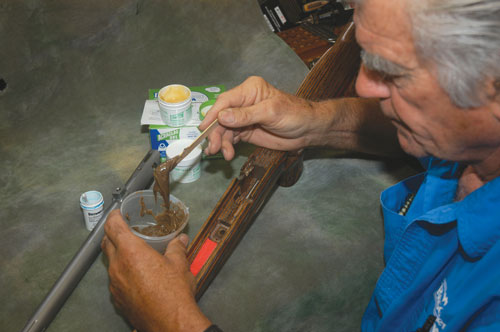 My first muzzleloader was a sidehammer .50-caliber that wouldn’t group five shots under 6 inches on my best day. Of course, I didn’t know a thing about muzzleloaders and tuning them for peak accuracy at the time. I had for years been an avid predator and varmint hunter and target shooter and spent my spare time building and restocking rifles and tuning them for peak performance. One of the first things I learned about consistent accuracy for a varmint or target rifle was the importance of proper bedding for the action, recoil lug and rear portion of the barrel.
My first muzzleloader was a sidehammer .50-caliber that wouldn’t group five shots under 6 inches on my best day. Of course, I didn’t know a thing about muzzleloaders and tuning them for peak accuracy at the time. I had for years been an avid predator and varmint hunter and target shooter and spent my spare time building and restocking rifles and tuning them for peak performance. One of the first things I learned about consistent accuracy for a varmint or target rifle was the importance of proper bedding for the action, recoil lug and rear portion of the barrel.
Modern muzzleloaders are a far cry from those made 20 years ago. The metal in the barrels and actions are superior and the tooling and machining are more precise than previously thought possible. The stocks are works of art, made of tough, durable laminated wood or composite materials turned out on precise and accurate pantographs or duplicating lathes.
However, in order for companies to mass-produce stocks that easily accommodate any barreled action off the assembly line, they have to leave several thousandths of an inch gap at critical bedding points, such as where the barrel and action are supported by the stock, the recoil lug and rear tang. If these were precisely fitted for the best of accuracy, assembly and disassembly of your favorite muzzleloader would require considerable effort accompanied by the judicious use of a mallet.
Muzzleloaders are known for their individual idiosyncrasies, and when you have to pour or drop a powder charge down the barrel, followed by ramming and jamming a patched or saboted bullet on top of the load for each shot, any variation in critical bedding areas can result in barrel and action movement that will affect first-shot placement and the overall grouping capabilities of the muzzleloader.
A good stock maker can fit the wood of a stock to the metal of the action with unbelievable precision and almost zero tolerance for movement between the stock and action. This vanishing art of precision wood and metalworking is available only on custom guns, as it’s far too costly and time-consuming for production-model firearms.
Glass bedding for a perfect fit between these critical areas of stock and action is easily and cheaply accomplished by any muzzleloader with a penchant for performance from their firearms and will produce results equivalent to that of the finest custom stock maker at a fraction of the cost.
 Step By Step
Step By Step
When I was doing gunsmithing in college and in the U.S. Army, I started out using Brownell’s AcraGlas bedding kits. I have stayed with them for 50 years, as I have found nothing better, easier or cheaper to use for all sorts of bedding adaptations. There are several different kits available ranging in price from the original Acraglas kit at $24.95 to the newest pre-mixed fast-action kit at $41.95 available direct from www.brownells.com or www.midwestusa.com.
Disassemble and clean your muzzleloader thoroughly to remove grease and gunk from the barrel, the action and the interior of the stock. Read the directions on the glass bedding kit several times and spend some time studying your stock to familiarize yourself with just where you need the bedding reinforcement. The recoil lug is the key location to get a tight fit that will hold the action immoveable shot after shot. I generally take a small wood chisel or Dremel tool and ground out space at the rear of the lug recess to provide a better glass bond and strengthen this area a bit. I also undercut the lower edges and front slightly for the same reason. Scrape the wood lightly to get down to bare wood and remove any dirt or grease that might interfere with the adhesion of the glass to the wood surface.
Some manufacturers overdo the size of the ramrod slot and just gouge out a trough much larger than needed. This will take to much glass to fill, so I fill this slot with kid’s modeling clay to keep the liquid glass where I want it. Depending on the action conformation, I glass the stock from about two inches in front of the joint of barrel and action to behind the recoil lug.
I carefully tape the outside of the stock where the glass bedding will be with 2-inch masking tape to facilitate cleaning up and to keep the glass off the wood or stock material.
The key to the ease of your glass bedding operation is getting all the metal portions of the barrel and action that will contact the liquid glass material thoroughly covered with the provided release compound. The slightest crevice or cranny that the glass can seep into and harden will give you fits when it comes time to remove the barreled action from the stock. Fill all holes or undercuts in the action or barrel with wood putty, clay or other substance and then cover them with several coats of release agent.
The recoil lugs on Austin Halleck muzzleloaders are dovetailed into the barrel and held by a counter-sunk bolt. I fill the grooves and ridges on the lug with liquid steel and then file and polish them smooth before applying release agent. It’s more work and effort, but it’s better than ending up with a one-piece muzzleloader with a non-removable stock — although this might prove to be an exceptionally accurate gun.
I pour, spoon or squirt a liberal quantity of the mixed bedding compound into the stock, keeping the compound away from the bedding screw holes as much as possible. I then carefully set the barrel and action into place. I always doubly dose all action seating screws with release compound. The glass will start to stiffen within 30 minutes or so depending on type used, and after a couple of hours I carefully loosen the bedding screws to make sure they aren’t glued permanently into the threads, a safety precaution that has on rare occasion diverted a problem. I then retighten the screws and leave the bedded gun for 48 hours to completely cure.
The moment of truth comes when you get the now perfectly and tightly bedded action out of the stock. Smooth the glass bedding down on the top of the stock and around the inletting and clean up any rough edges in the stock. Voila! A perfectly bedded muzzleloader that, when tuned with the right powder, bullet and sabot combination, should give you a lifetime of consistent “on-the-spot” accuracy and dependability.






